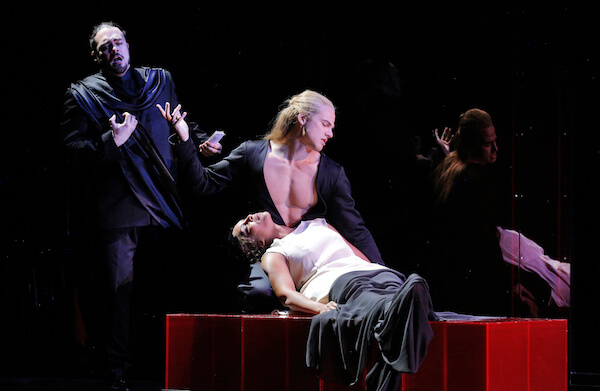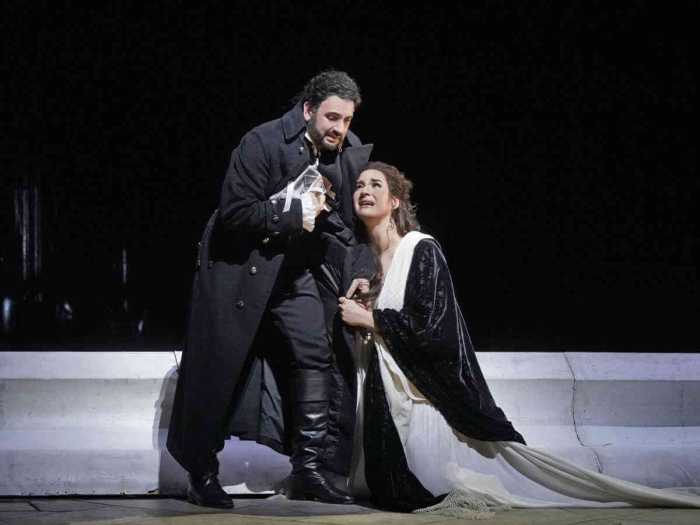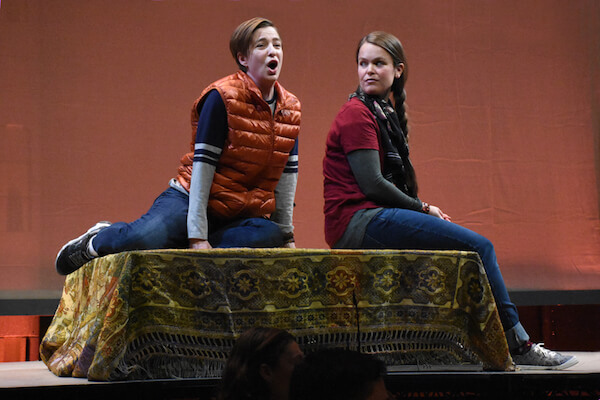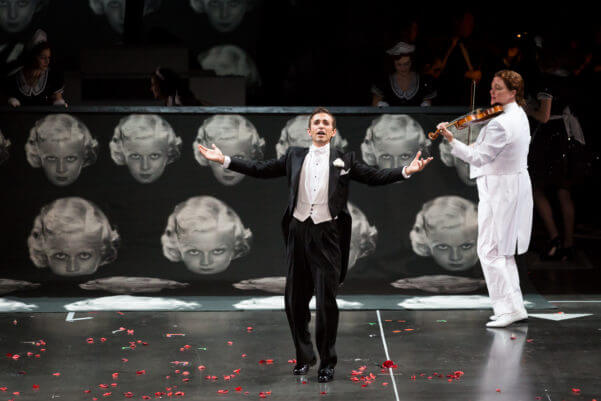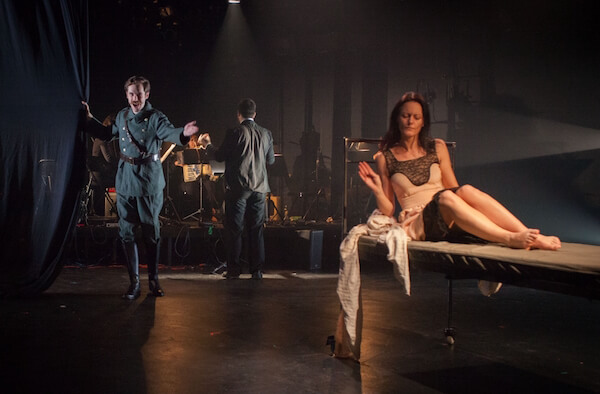Gerard Schneider, Douglas Williams, and Talise Trevigne in James Darrah’s production of Pietro Mascagni’s “Iris” at Bard SummerScape. | CORY WEAVER
In the early 1880s, two young Italian composers studied together at the Milan Conservatory, sharing an apartment and living the bohemian life of struggling artists. Their names were Pietro Mascagni and Giacomo Puccini, and for a time they led parallel lives. Five years younger than Puccini, Mascagni found success first in 1889 with his one-act “Cavalleria Rusticana”, a gritty melodrama set on the mean streets of Sicily. “Cavalleria” inaugurated the verismo movement, and Mascagni spent the rest of his career trying to duplicate its success.
The verismo label is applied indiscriminately to Italian operas written in the last quarter of the 19th century. But the musical styles of the verismo school composers show the international influences of Massenet, Strauss, and Wagner and their dramatic subjects vary widely. Mascagni himself diverged from the Zola-like realism of “Cavalleria” with historical tragedies, 18th century comedies, sentimental rustic romances, and the oriental symbolist opera “Iris.” A stylized drama of an innocent Japanese girl abducted and ruined by corrupt men, “Iris” was a huge success at its 1898 premiere and was considered Mascagni’s full-length masterpiece. It remained in the standard repertory in Italy and South America until World War II.
Puccini eventually hit it big in 1893 with “Manon Lescaut” and went on to write hit opera after hit opera. One notable Puccini flop was “Madama Butterfly”, another oriental tragedy concerning an innocent Japanese girl that was booed off the La Scala stage at its 1904 world premiere. “Butterfly,” however, proved hardier after Puccini repaired her broken wings in multiple revisions until success was achieved at the Metropolitan Opera and worldwide. “Iris” was initially more popular and successful than “Butterfly” in Italy but faded from the repertory in the mid-20th century along with Mascagni’s other non-“Cavalleria” operas. Meanwhile, Puccini’s operas never leave the repertory: “Butterfly” was revived at the Met just last season while “Iris” was last performed there in 1931.
Bard SummerScape revives Pietro Mascagni’s “Iris,” a long-ago repertory standard
“Iris” was revived this summer as the centerpiece of the “Puccini and his World” theme of the Bard SummerScape 2016 Festival curated by Dr. Leon Botstein. However, despite what Botstein’s program notes say, Bard’s fully-staged “Iris” production is not “the first major professional North American staging in nearly a century.” Alfredo Silipigni of the New Jersey State Opera presented a staged production in Newark in 1988 with Adriana Maliponte and Jerome Hines. The enterprising Teatro Grattacielo programmed a semi-staged concert a decade later — both of these productions were more than professional.
Not only does “Iris” share subject matter with “Butterfly” but it shared one of its librettists, Luigi Illica. Illica’s libretto for “Iris” has elements of symbolist drama: the characters are archetypes rather than individuals in a Japan that is more fantasy than reality. The title heroine is a pure flower — a child of nature who longs for the rays of the sun. The urban roués who abduct and attempt to defile her in a Tokyo brothel are named after Japanese cities — Osaka and Kyoto. Iris’ bigoted, unforgiving blind father is simply named “Il Cieco” — the blind one.
The story, however, is not derived from a Japanese source and is late 19th century European in tone and outlook. The final act, set in a sewer, baffled early audiences with its expressionist elements — we don’t know if what we see is real or in the mind of the dying heroine. Mascagni’s impressionistic score has elements of Wagner (low rumbling double basses in the preludes to the first and last acts lifted straight from the “Ring” operas) and Massenet’s fragile French exoticism. Mascagni stretches harmony to the limit, creating a sense of suspended time. The orchestration is lush, inventive, and sweepingly romantic with sprinklings of Japanese instruments and folk melodies as in Puccini’s later “Butterfly” and “Turandot.” Familiar excerpts include the inspiring choral “Hymn to the Sun” that opens and concludes the opera and Osaka’s tenor serenade “Apri la tua finestra,” which is programmed on vocal recitals. But there are many other haunting melodic pages in this score.
James Darrah’s production at Bard freed the opera from its Japanese milieu, setting it in an unspecific time and place. The tale might be happening in Africa, as with the kidnapped Nigerian schoolgirls, or anywhere in China, India, or Eastern Europe where young rural girls are abducted and trafficked. Darrah also didn’t shy away from the opera’s expressionist and symbolist elements evoking ancient Greek theater and surrealist art.
Botstein’s conducting emphasized the invention and sweep of Mascagni’s eclectic yet very Italian score. The voices were all capable and fresh. Talise Trevigne in the title role unleashed a vibrantly pure soprano voice combining shimmering overtones with lush undertones. Though she lacks the verbal incisiveness and stylistic authenticity of Italian verismo specialists like Magda Olivero, her sweet voice was more inherently innocent and virginal. And in the dramatic second act aria, Trevigne opened up her tone with declamatory power.
As Osaka, tenor Gerard Schneider handled the difficult high tessitura ably but pushed isolated high notes too hard. Baritone Douglas Williams, done up as a combination of Fabio and Orlando Bloom as Legolas, brought a soft-grained lyricism to a role that could use darker thrust and snarl. As Il Cieco, Matthew Boehler’s smooth bass sounded too humane and youthful for such an intransigent old man. Mezzo Cecilia Hall as the geisha brought an arresting dark tone to her role in the puppet show that foreshadows Iris’ sad fate.
The drama and the characters in “Iris” are static. Puccini’s Cio-Cio San grows into a tragic woman who determines her fate whereas Iris remains a passive child, more symbol than person. The late 19th century symbolist and orientalist avant-garde artistic movements have become outmoded and passé in our time. But Mascagni’s imaginative score for “Iris” is not a tired relic — it defies time and fashion and deserves to be heard.
The withdrawal of Hei-Kyung Hong from the Metropolitan Opera’s 2016 revival of “Madama Butterfly” occasioned the return of two superb American sopranos inexplicably neglected by the Met’s casting department. Ana María Martínez debuted at the Met as a lovely Micaëla in Carmen over a decade ago and didn’t return until last fall as Musetta in a lackluster “Bohème” revival. Meanwhile, she has been singing at venues like the Paris Opéra and Glyndebourne with distinction.
Only a week before the scheduled February 19 “Butterfly” opening night, Martínez jumped into Anthony Minghella’s production during the hiatus before beginning rehearsals for a scheduled run of “Butterfly” at the LA Opera. She proved herself a masterful musician and actress, carefully pacing herself in this marathon role. As Cio-Cio San, Martínez held back in Act I, suggesting more a contained mature noblewoman rather than the excited teenaged bride. Her port wine-colored lyric soprano was cool rather than passionate, and she held back on high climaxes. However in Acts II and III, we saw that this was part of a carefully paced interpretation that gradually increased the emotional and vocal tension scene by scene, culminating in a cathartic final suicide. Martínez’s subtle restraint and incisive phrasing created a tragic rather than pathetic heroine. Note to the Met casting department: more please and soon.
Roberto De Biasio sounded pale and strangulated as Pinkerton –– strange since he sang so well in more demanding Verdi roles in earlier seasons. Polish baritone Artur RuciÅ„ski made a promising debut as Sharpless, with a smooth, fruity baritone voice and empathetic stage manner. Maria Zifchak’s familiar Suzuki was warmer in her emotional connection to her mistress than previously. Debutant conductor Karel Mark Chichon elicited superb playing from the Met orchestra with broadly romantic tempos that kept the musical and dramatic momentum moving forward. He was a supple accompanist to the singers as well.
Martínez’s rehearsal schedule at the LA Opera prevented her singing all the performances, and Latonia Moore jumped in as Cio-Cio San on March 2, with even less notice and practically no rehearsal. In March 2012, when Moore made her surprise Metropolitan Opera debut subbing as Aida at a matinee broadcast on the radio, she was at least the contracted cover and had some familiarity with the staging. Oddly, in “Butterfly,” one never sensed any dramatic uncertainty –– Moore seemed to know 90 percent of the staging and confidently faked the rest. She owned the role confidently, placing her own personal interpretation into this production. Moore’s temperament is the opposite of Martínez’s –– her Butterfly was emotionally open and extroverted from the outset. She enthusiastically entertained the crowd at the wedding party like the former geisha she was, playing the hostess telling stories and making jokes for her guests.
Still, the stress of the occasion showed in momentary losses of vocal control in a few exposed places –– high notes that veered off center or a pianissimo that faltered. Otherwise, Moore’s Cio-Cio San was as golden and generous of voice as she was golden and generous of heart. Moore must return to the Met in this role –– but in a full run of scheduled performances with ample rehearsal time.
Welsh tenor Gwyn Hughes Jones’ soft-centered tone was too light in the middle and pushed on top but otherwise sounded pleasant as Pinkerton. Carolyn Choa, Minghella’s widow, has lovingly maintained his production, which has now seen over a decade of service. It looked as fresh and beautiful as ever.

